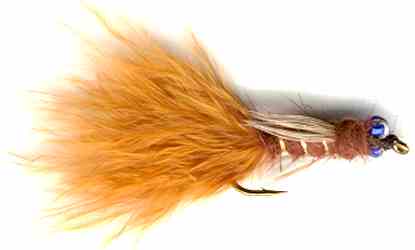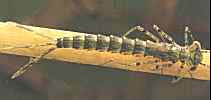Brown Glass Eyed Damsel Nymph
As soon as you see a flash of a Common Blue Damsel fly dart across the river you know Summer is just about here. The Damsel aquatic subsurface nymph fly pattern has been used on nearly every small to medium sized stillwater in Britain with great success.

DAMSEL NYMPH FLY PATTERNS. Hook size 10- $US each
It is also a good river fly nymph pattern for Brown Trout, Rainbows and Grayling. You normally only find Damsel flies around the edge of the bigger lakes and reservoirs so they are not as popular with the boat using deep water nymphing fly fishermen. The problem for the early fly tiers was to try to design a fly that would recreate the the wiggling motion of the natural insect as it hunted for grubs to eat on the river or lake bed.
When marabou feathers were introduced to make streamer lure fly patterns come to life on the retrieve, nymph fly designers added this material to there creations to make a good Damsel Nymph imitation. It has three pairs of legs and pincers as part of its mouth for grabbing any unsuspecting smaller insect for dinner. They are vicious hunters and bigger than most Mayfly and Caddis young, whom they consider food. The damsel Nymph is a good fly to fish slowly on or near the bottom. This is where the natural lives. While the shape of this fly is important it is the movement of the fly in the water that really makes it work well and that is down to the marabou tail. The outline of the bulging eyes are imitated by the glass beads and the three pairs of legs by the side hackles. The legs on the natural insect are just used for crawling. They are kept by its side when swimming to a new location.

Damsel nymph fly patterns can often turn a fishless fishing day out to a successful one. They are overlooked by many fly fishing trout anglers. A damsel nymph offers a substantial meal to a hungry fish and worth the effort to investigate. When you notice adult blue, claret or brown damsels fly along the river as they hunt smaller airborne insects try a damsel nymph fished close to the aquatic weed beds or over hanging partially submerged river or lake side plants. These are the preferred areas that damsel nymphs like to hatch as they need a place to fly to and rest so that their newly hatched body can have time to recover and get stronger. If you are having difficulties discovering what the trout are feeding on try fishing a damsel nymph in the slower water found near these water features.
In faster moving water try a dead drift presentation of a damsel nymph. Cast upstream and allow it to go with the flow as if the water current has plucked it from the river bed. As you get near vegetation retrieve the line so that when you get a take you will be able to set the hook as there is no slack in the line
Not all fly fishermen have seen trout take the adult damsel. I have witnessed them jump out of the water and take a hovering blue damsel on the rivers I fish in the South of England. They are normally hovering low to the water to avoid predation by birds and are about to land on a leaf or flower stem. They are particularly at risk when they are in a mating embrace. I do not think that adult damsels are actively sort after as a trout food source but if the opportunity arises and the fish are high in the water they will leap and try to bag themselves a substantial meal. Cast your dry adult damsel fly near water edges that have low hanging vegetation.
Life cycle of the Damsel Fly
The damselfly is a relative of the Dragon Fly. Summer stillwater trout love to eat them. It is the nymph form of the insect that interest them the most but if they can catch the adult Damsel fly then that makes a trout very happy. The unmistakable vivid blue adult insect represents a substantial meal. Sometimes they are luck and catch two, in the act of mating, in one bite.
The Damselfly’s life cycle starts when the female lays her fertilised eggs on a stone or piece of vegetation under the water surface. After a short time the eggs hatch and become tiny damselfly larvae. Unlike many aquatic insects that grow large enough in one year to hatch into their adult form, damselflies can take up to five years.
During the time they spend on the lake or river bed they viciously prey on smaller insects and consume decaying vegetable matter. To increase their size they shed their hard outer skin. The nymph has a long slim body. It swims by using slow but graceful, movement. It flexes its lower body from side to side to propel itself through the water. When hunting it can move in fast short bursts of speed. It likes to live and hunt around weed beds as when threatened by hungry fish it can seek cover.
When it is time for the nymph to hatch into the adult Damsel Fly it will crawl out of the water onto a boulder, weed stem and even a fly fisherman’s wadding boot. This normally occurs on warm sunny days. Here the nymph sheds its skin for the final time and the adult is revealed underneath.
A few days before this process happens the insect becomes more active. It has to swim to the surface to breath air. This is when it is particularly susceptible to marauding trout.
Look for structure when fishing a Damsel Nymph
I like to use a 10ft 7wt rod. The more distance you can cast the longer the fly is in the water and available for inspection by more fish. You can use a number of different lines when fishing with damsel nymph flies but my choice would be either the midge tip or intermediate line. The reason for these lines being do effective, compared with the others, is that they allow you to retrieve the fly on a level plain, just like the natural. You stand more chance of catching trout that are feeding on damsel nymphs if you can keep your fly at a certain level and bring the fly all the way back to the rod tip.
If you get the chance, try to study the movement of damsel nymphs in clear water. They are aggressive predators and powerful swimmers. You will see they swim from one location to the next, looking for their next meal. The good old figure-of-eight is one of the best retrieves. Try to mimic the speed of the natural insect, slow and steady.
Another way you can try to imitate the movement of the natural insect is to make a 1ft pull and at the same time vibrate the rod tip up and down with your casting hand. The long marabou tail of your fly will do the rest.
You will find damsels in most still waters and slow moving rivers and canals. My local river is full of them. Weed beds are the most favourite habitation for damsel nymphs, especially the long stemmed weeds. They like to wait on the underside of the leaves to ambush their prey. They also have to crawl out of the water to emerge. The trout know this and lurk nearby.
Any type of vegetation, boat docks, boulders, tree branches, fence posts will attract Damsel nymphs. It is from these structures that they will crawl up and emerge as adults. If you want to make your river or lake more healthy consider planting tall water lilies. They look pretty but also provide shelter for juvenile fish and damsels.
I fish an adult Damsel fly imitation dead drift and give it a small twitch to mirror the action of an egg laying female. The trout are very switched on to this seasonal food source and actively look up to the surface for them.


Fly Fishing books

